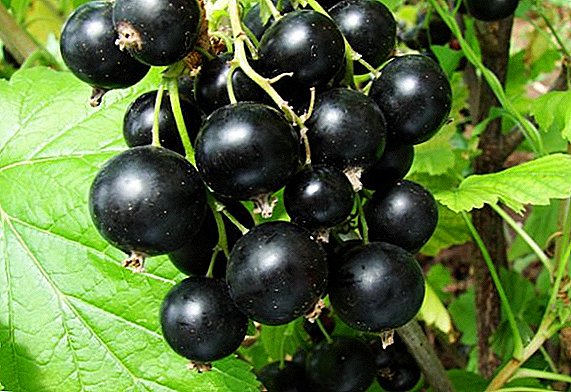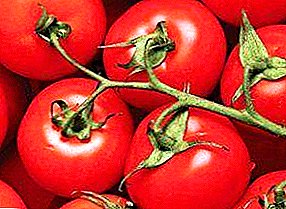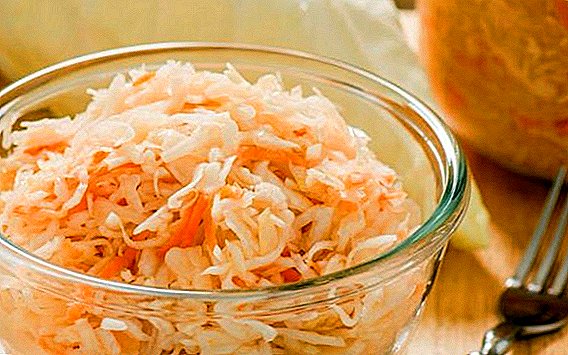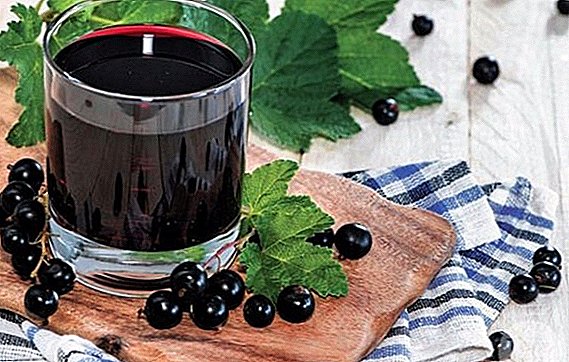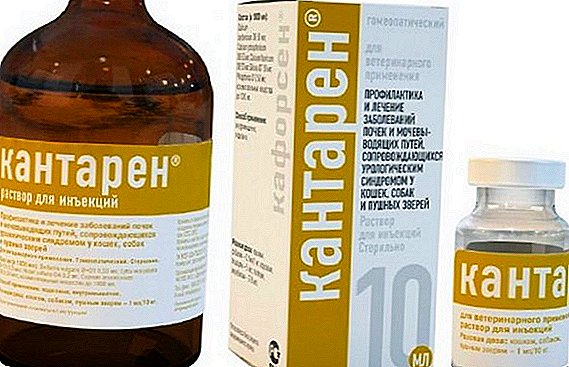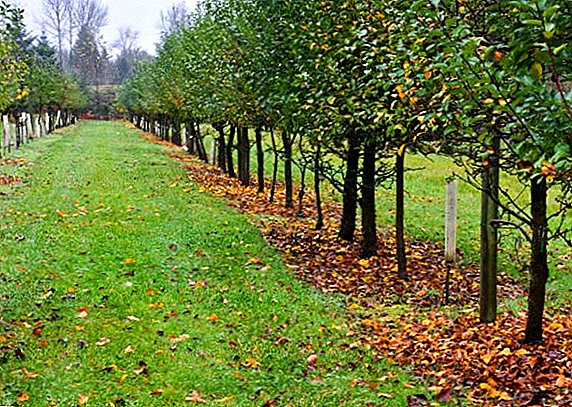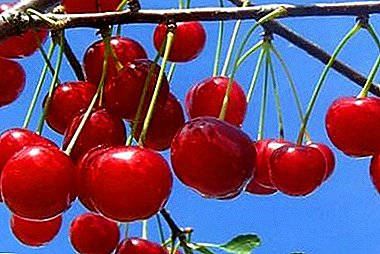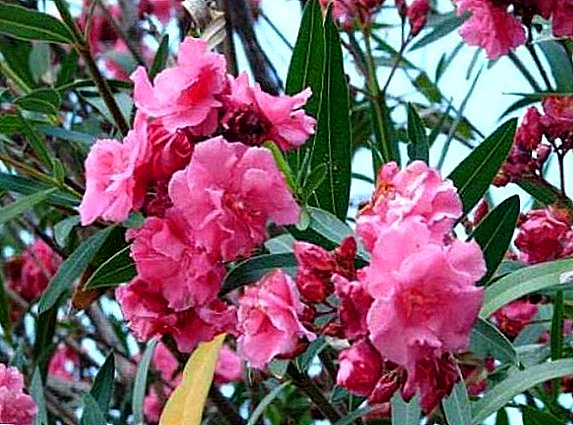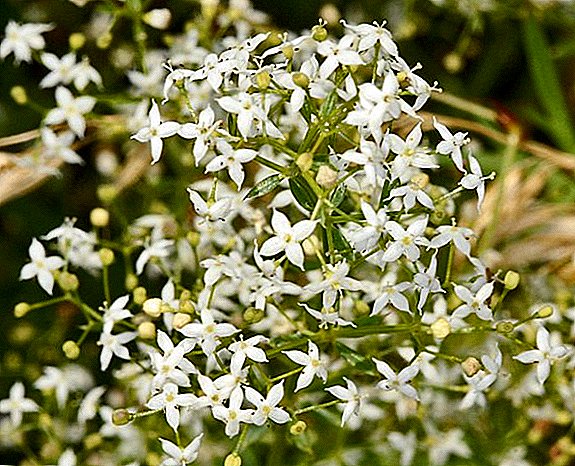 The soft bedstrap has long been known as a medicinal plant, which has a number of useful properties and helps with various diseases. We offer to find out what ailments can be treated on the basis of this plant.
The soft bedstrap has long been known as a medicinal plant, which has a number of useful properties and helps with various diseases. We offer to find out what ailments can be treated on the basis of this plant.
How it looks and where it grows
Soft bed (lat. Gálium mollúgo) is a perennial belonging to the Marenov family. This herb grows 0.25-1.25 m tall. Its stems have a tetrahedral shape, with growth going up. The leaves are collected in whorls, in which usually there are six to eight leaves with a length of 2 cm and a width of 0.25 cm. In shape, they are obverse-lanceolate-shaped. They can also be pointed or oblong.
Grass blooms from early summer through early fall. At this time, the plant produces inflorescences in the form of a spreading panicle, which contain branched peduncles. Flowers of white color, 0.2-0.5 cm in diameter. Having a pleasant smell, the flowers make the plant a honey plant.  After flowering, the bedstraw brings dry fractional fruits of brown, green or black, which fall into two seeds.
After flowering, the bedstraw brings dry fractional fruits of brown, green or black, which fall into two seeds.
Bedstraws can often be found on meadows, fields, along fences and highways, near water bodies, in open areas under the open sun. He is an inhabitant of the forest and forest-steppe zones of the Northern Hemisphere. Known to residents of Eurasia, North Africa.
In the people, in different territories, the soft pad also bears the names deryabka, cosmo-grass, marbles, mouthpieces, black metlyuk.
For animals, the grass is poisonous - when they eat, they get serious poisoning.
Did you know? The scientific name for the genus of the bedstraw, Gálium, was given from the Greek word gala - milk. The reason is that when cows ate grass, their milk changed color to reddish and quickly sour. Because of the latter property - quick grazing of milk - the Tatars called the bedstrap yogyrtom.

Chemical composition
A description of a soft bedstrap will be incomplete without information about its chemical composition.
In a herbaceous plant are present:
- vitamin C;
- carotene;
- acids: citric, gallotanin, chlorogenic;
- macro- and microelements: iron, molybdenum, manganese, chromium, strontium, titanium, vanadium, nickel, zinc;
- flavonoids;
- tannins;
- pigments;
- essential oil;
- coumarins;
- anthraquinones;
- saponins;
- rennin.

Medicinal properties
The rich chemical composition provides a soft bedtime with several healing properties:
- immunomodulatory;
- disinfectant;
- sedative;
- painkillers;
- urinary, sweat- and choleretic;
- astringent;
- hemostatic;
- anti-inflammatory;
- estrogen.
With convulsions, chernokoren medicinal, ivy-shaped budru, an amaranth upturned, verbeynik, horseradish, mountain arnica, iglitsa, black cohosh, hop, parsnip, enoteru are used.
Properly prepared and used means, according to the observations of folk healers, help calm the nervous system when overexcited, relieve cramps, lower blood pressure. They are also effective in treating conjunctivitis, pancreatic and gastrointestinal diseases.
Recommended as external and internal use of folk remedies. 
Did you know? Title "bedstraw" derived from the pre-Slavic word "Marati", which translated means "smudge". The fact is that yellow and green dyes for natural fabrics are made from the flowers of those types of bedstraws that are colored yellow..
Use in traditional medicine: recipes
Soft bedstrap found use in traditional medicine. It is one of the ingredients used in Tibetan medicine. In traditional medicine, the herb is not part of a single medicine, although it is listed in the register of medicines of the Russian Federation as permitted for homeopathic treatment, and the other species, a bed-datum, is allowed as a raw material for dietary supplements.
Tea
Tea from the bedtime is prepared as follows: Pour two tablespoons of herbs into freshly boiled water (400 ml). Together with grass water boil for two minutes. After the tea has cooled, it should be drained. The maximum amount of drink you can drink per day is two or three cups.
Tea is advised to drink during the inflammatory process in the bladder, edema, cystitis and other problems with the urinary system, diseases of the heart and blood vessels. It is effective for those who need to calm the nervous system.
Chamomile, mint, lemon balm, lavender, medicinal clover, tricolor violet, cyanosis blue, wood louse, fir, pine cones, tarragon, quince, blackberry, calendula have a sedative effect.
 Also, tea is used as an external agent - lotions with it are applied to wounds and sunburns. In this case, the tea should be stronger.
Also, tea is used as an external agent - lotions with it are applied to wounds and sunburns. In this case, the tea should be stronger.Decoction
The broth is recommended to drink with abdominal pain associated with a violation of the digestive tract, if you have kidney pain, bladder, or with dropsy, to lower blood pressure, to establish the work of the heart. It is believed that the decoction helps with boils, eczema, ulcers.
The tool is prepared from two teaspoons of herbs, which is kept on a water bath with a glass of boiled water for a quarter of an hour. Broth insist 30 minutes and filter. You need to drink a tablespoon four times a day.
For nervous disorders, the broth is prepared by pouring 40 g of grass with a liter of boiling water and keeping it on the stove for about five minutes. After straining drink a tablespoon three times a day.
If the same broth insist for two hours, then it can be used for liver disease. After insisting and filtering, they drink half a glass or a glass three times a day half an hour before meals. Treatment should be continuous for three to five weeks. 
Infusion
For the preparation of infusion need two tablespoons, filled with two cups of boiling water. The facility is allowed to stand for an hour. It is better if the insistence will occur in a thermos.
Drink a third of a glass four times a day. It is recommended for dermatosis and dermatitis, urolithiasis, diarrhea, edema, problems with the gastrointestinal tract, furunculosis, gynecological diseases. Outside infusion wipe wounds, diseases of the skin, ulcers.
Tincture
To prepare the tincture you need to take the grass, put it on the bottom with a layer of 2-3 cm in a liter jar, pour vodka. The tincture should be kept in a dark place for 21 days. This tool is used externally to relieve pain in arthritis - it is rubbed into sore spots. It is also an effective drug for relieving pain and fatigue from the hands of people engaged in hard physical labor.
In case of arthritis, the healing properties of the larkspur, marigolds, momordiki, scoroneri, plectrantus, marsh wild rosemary, echinacea, gentian, juniper, veronica officinalis, yucca are treated.For skin diseases, it is also advised to take bath with bedstraws. To do this, 100 g of grass brewed in 3 liters of water. After straining, add to bath when bathing.
 But the juice of the plant they drink two teaspoons three times a day, mixing with honey, with impotence. It is also used for wiping hard to heal wounds. For the same purpose, powder from dried flowers of a bed-bed is poured on the damages, or an ointment of 10 g of dried flowers mixed with 100 g of butter is applied.
But the juice of the plant they drink two teaspoons three times a day, mixing with honey, with impotence. It is also used for wiping hard to heal wounds. For the same purpose, powder from dried flowers of a bed-bed is poured on the damages, or an ointment of 10 g of dried flowers mixed with 100 g of butter is applied.There are also many remedies for various diseases in which the bedstraw is included as one of the main components.
Important! Do not use folk remedies as the main therapeutic method. They can only complement the treatment. Before you begin to apply them, you must consult a doctor.
Collection, preparation and storage of medical raw materials
The collection of medicinal raw materials should be carried out during the period when the herbaceous plant is in bloom - that is, from June to September. For the preparation of means used only flowers. Panicles are cut and then dried in limbo. They need to be tied up in bunches and suspended under a canopy in a place where the sun's rays do not penetrate and there is good air access.
Inflorescences can also be dried indoors, the main thing is that it is well ventilated. They are hung on a string in a vertical state or laid out in a single layer on paper or fabric. Store raw materials must be in a glass container in a dark dry place. Also suitable for storage fabric bags and paper envelopes. The shelf life of dry grass should not exceed two years.
Store raw materials must be in a glass container in a dark dry place. Also suitable for storage fabric bags and paper envelopes. The shelf life of dry grass should not exceed two years.
Contraindications and harm
Like any medicinal herb, a soft bedcloth is able to bring both good and harm.
Since the bedstraw has a strong diuretic effect, remedies based on it diabetics are contraindicated.
Due to the fixing action of the dish and remedies, it is not necessary to ingest for children of any age and pregnant.
It is also worth considering the fact that some people may have individual intolerance to the substances that make up the herb.
Important! Since non-compliance with the proportions in the recipe can be observed poisoning and other undesirable reactions, it is necessary to strictly adhere to the specified dosage..
Bedstraw is a common herb used in traditional medicine and in cooking. When deciding to use the means on the basis of this herb for therapeutic purposes, it is necessary to familiarize yourself with the list of contraindications and inform about your intention to your doctor.


